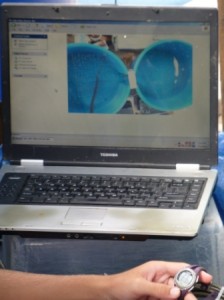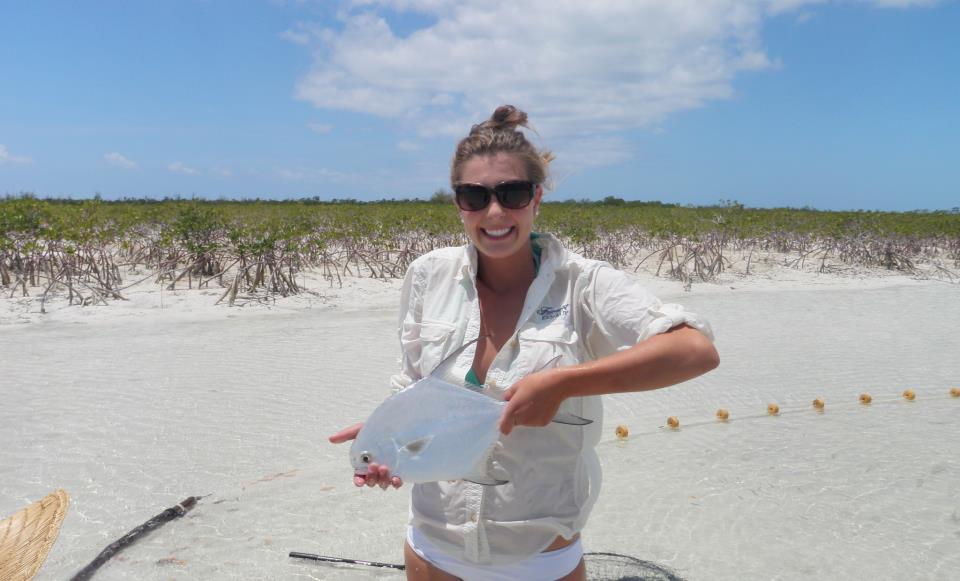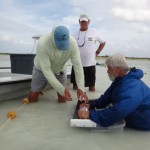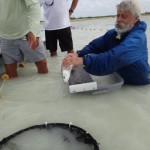Wading in the middle of the tidal flats of northeast Grand Bahama, the untrained eye wouldn’t even begin to recognize the magnitude of life hidden among the cryptic maze of creeks and mangrove cays… but that’s not the case for Greg Vincent, Jason Franklin and the rest of the H2O Bonefishing crew who miraculously navigate this mangrove labyrinth and interpret the slight intricacies at the water’s surface to point out unseen schools of fish all around. It is this often unrecognized magnitude of life and diversity that the CEI Flats Ecology & Conservation team, guided by the volunteered resources and experience of H2O Bonefishing, seeks to understand and protect. This past week, Dave Philipp, Aaron Shultz, Brian Shultz, and Ian Rossiter of the CEI Flats team, along with Jeff Koppelman from the Fisheries Conservation Foundation (FCF), Karen Murchie from the College of Bahamas (COB), and others from the Bahamas Initiative [a joint venture between CEI, FCF, and Bonefish & Tarpon Trust (BTT)] have ventured out into the Grand Bahama flats ecosystem with hopes of capturing and tagging 500+ bonefish (Albula vulpes).
water’s surface to point out unseen schools of fish all around. It is this often unrecognized magnitude of life and diversity that the CEI Flats Ecology & Conservation team, guided by the volunteered resources and experience of H2O Bonefishing, seeks to understand and protect. This past week, Dave Philipp, Aaron Shultz, Brian Shultz, and Ian Rossiter of the CEI Flats team, along with Jeff Koppelman from the Fisheries Conservation Foundation (FCF), Karen Murchie from the College of Bahamas (COB), and others from the Bahamas Initiative [a joint venture between CEI, FCF, and Bonefish & Tarpon Trust (BTT)] have ventured out into the Grand Bahama flats ecosystem with hopes of capturing and tagging 500+ bonefish (Albula vulpes).
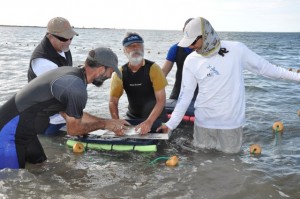 So why are we going to so much effort to tag these bonefish? As any sports angler will tell you, bonefish are the fish to catch in the Bahamas. So much so, that the revenue generated toward the Bahamian GDP by catch-and-release bonefishing has been estimated to be over $140 million (that’s a lotta bones… get it). Despite their value, we know very little about the natural history of this species. We don’t know its home range, migration patterns, spawning location/timing/behavior, etc… Without this knowledge, any conservation effort toward this valuable species is really just a shot in the dark. That’s where the tags come in. Continue reading
So why are we going to so much effort to tag these bonefish? As any sports angler will tell you, bonefish are the fish to catch in the Bahamas. So much so, that the revenue generated toward the Bahamian GDP by catch-and-release bonefishing has been estimated to be over $140 million (that’s a lotta bones… get it). Despite their value, we know very little about the natural history of this species. We don’t know its home range, migration patterns, spawning location/timing/behavior, etc… Without this knowledge, any conservation effort toward this valuable species is really just a shot in the dark. That’s where the tags come in. Continue reading
Category Archives: Flats
The Story of Sharks film update
After visiting the Blue Ocean Film Festival as finalists in September, Ian Rossiter (Flats Team intern) and Brendan Talwar (Shark Team intern) submitted their film to the Festival Mondial de l’Image Sous Marine (World Festival of Underwater Images) in Marseilles, France. After a few weeks, they received an email announcing their first award, granted by the French Federation of Film and Video. With this exciting announcement came the news that winning films would be shown across the world at small film festivals everywhere. The first venue to showcase the winning films was the Miami Underwater Festival from November 30 to December 2, 2012, where the Story of Sharks was shown to young audiences at the Miami Science Museum. On the same weekend, the video was shown to the Bahamian Minister of the Environment at the Cape Eleuthera Institute/Island School Research Symposium. The next step is submission to a few more festivals around the Bahamas and United States before distribution online. (Photo of Brendan (L), Ian (R), and their mentor, Didier Noirot).
The first venue to showcase the winning films was the Miami Underwater Festival from November 30 to December 2, 2012, where the Story of Sharks was shown to young audiences at the Miami Science Museum. On the same weekend, the video was shown to the Bahamian Minister of the Environment at the Cape Eleuthera Institute/Island School Research Symposium. The next step is submission to a few more festivals around the Bahamas and United States before distribution online. (Photo of Brendan (L), Ian (R), and their mentor, Didier Noirot).
New shuttle box trials being conducted at CEI
CEI recently started performing shuttle box experiments in the wet lab. The set-up of the shuttle box system is simple: two tanks are connected through a short “walkway”, and above the tanks a camera is mounted to monitor the fish movements, with little human interference on fish behavior.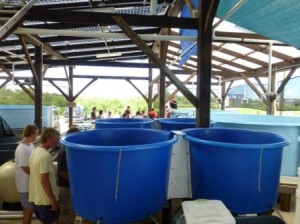 The shuttle box trials complement the critical temperature experiments that the Flats team wrapped up in early October 2012. These experiments tested the range of temperatures that a fish can tolerate before losing equilibrium, and are used to study how the projected conditions for climate change will affect fish in the flats ecosystems.
The shuttle box trials complement the critical temperature experiments that the Flats team wrapped up in early October 2012. These experiments tested the range of temperatures that a fish can tolerate before losing equilibrium, and are used to study how the projected conditions for climate change will affect fish in the flats ecosystems.
The shuttle box comes provides a unique aspect while studying effects of climate change, by adding a behavioral decision-factor element to the study. Trials will be run using one the common mangrove prey species (bonefish, yellowfin mojarra, yellowtail snapper and checkered puffer) in one of the two tanks and a mangrove predator (juvenile lemon shark) in the other tank. Then, the environmental conditions in the prey tank are manipulated to an unfavorable level (i.e. high temperature) and the fish is viewed on the cameras to see when it decides that being in the same tank as the lemon shark, with the threat of predation, is preferred to unfavorable environmental conditions. Continue reading
CEI researchers and affiliates meet with members of the Bahamian government to discuss marine conservation
CEI researcher Aaron Shultz along with Fisheries Conservation Foundation chair Dave Philipp, Illinois Natural History Survey Fisheries Biologist Julie Claussen, and a young member of the CEI boathouse staff Mally Goodman, took a break from their bonefish tagging efforts to meet with the Prime Minister and the Environmental Ministry of the Bahamas at Deep Water Cay, Grand Bahama on Thursday.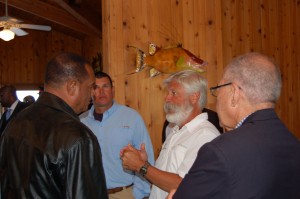 Aaron spoke to the group about conservation, and showed a slideshow on the research and tagging project currently being conducted on Abaco. Prime Minister Perry Christie talked pointedly on the importance of protecting the natural resources of the The Bahamas, as well as increasing research and education.
Aaron spoke to the group about conservation, and showed a slideshow on the research and tagging project currently being conducted on Abaco. Prime Minister Perry Christie talked pointedly on the importance of protecting the natural resources of the The Bahamas, as well as increasing research and education.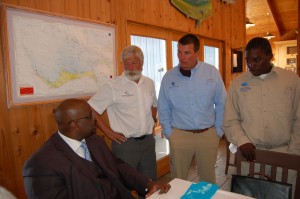
Many officials from the Bahamian government and members of the press attended the event, serving as great exposure for the Cape Eleuthera Institute, The Island School, Fisheries Conservation Foundation and Bonefish Tarpon Trust. The word is spreading on some of the work that CEI researchers are doing, great work guys!
Spotlight on Master’s student at CEI: Liane Nowell, Carleton University
I started my master’s at CEI in association with Carleton University in May 2012. I will be studying the thermal biology and spatial ecology of bonefish (for global warming implications) as a grad student in the Dr. Steve Cooke and Dr. Cory Suski labs of Carleton University and the University of Illinois, respectively.
The staff and faculty at CEI are a wonderful bunch of people. They are encouraging and eager to help me develop professionally and as a person. I really enjoy and appreciate CEI’s unique ability to engage in outdoor, experiential classrooms near Exuma sound. It’s nice to be a short boat ride away from the mangrove creeks that act as my study site. To date, I’ve been given the opportunity to work with a multi-disciplinary network of professionals including meeting and working alongside visiting world-class scientists, collaborating with other master’s students, both here and abroad, and working closely with a host of Ph.D. students at the institute. Continue reading
Bonefish tagging trip in Abaco update #1
In October, CEI researchers Aaron Shultz and Zach Zuckerman, along with Illinois Natural History Survey scientist and chair of the Fisheries Conservation Foundation Dave Philipp, took a trip to the neighboring island of Abaco to tag bonefish, as part of a Caribbean-wide effort to gain knowledge on the population dynamics and movements of these economically important gamefish.
Tagging efforts on Abaco were a huge success, despite having to deal with Hurricane Sandy. Early on in the trip, the team headed out to the Southern End of the Marls and captured several schools of bonefish that came in waves of 50-150 fish. Buddy Pinder, bonefish guide and member of the Abaco Flyfishing Guides Association helped them tag 162 fish on the first day of seining. The next day they saw piles of fish moving along the same shoreline and tagged an additional 496 bonefish! One of the fish had been tagged by Aaron two years earlier in Cross Harbour. The team suspects these fish are using this stretch of shoreline as a corridor to the southern end of the island, where fish aggregate prior to spawning.
